Sand/Stone
For an ambitious landscape design project, Magnus Larsson, a student at the Architectural Association in London, has proposed a 6,000km-long wall of artificially solidified sandstone architecture that would span the Sahara Desert, east to west, offering a combination of refugee housing and a "green wall" against the future spread of the desert.
 [Image: From Magnus Larsson's Dune: Arenaceous Anti-Desertification Architecture].
[Image: From Magnus Larsson's Dune: Arenaceous Anti-Desertification Architecture].
Larsson's project deservedly won first prize last fall at the Holcim Foundation's Awards for Sustainable Construction held in Marrakech, Morocco.
One of the most interesting aspects of the project, I think, is that this solidified dunescape is created through a particularly novel form of "sustainable construction" – that is, through a kind of infection of the earth.
In other words, Larsson has proposed using bacillus pasteurii, a "microorganism, readily available in marshes and wetlands, [that] solidifies loose sand into sandstone," he explains.
 [Image: From Magnus Larsson's Dune: Arenaceous Anti-Desertification Architecture].
[Image: From Magnus Larsson's Dune: Arenaceous Anti-Desertification Architecture].
Larsson points out the work of the Soil Interactions Lab at UC-Davis, which describes itself as "harnessing microbial activity to solidify problem soils."
But the idea of taking this research and applying it on a megascale – that is, to a 6,000km stretch of the Sahara Desert – boggles the mind. At the very least, the idea that this might be deployed for the wrong reasons, or by the wrong people, in some delirious hybrid of ice-nine, J.G. Ballard's The Crystal World, and perhaps a Roger Moore-era James Bond film, deserves further thought.
An epidemic of bacillus pasteurii infects all the loose sand in the world, forming great aerodynamic fins and waves in a kind of global Utah of glassine shapes.
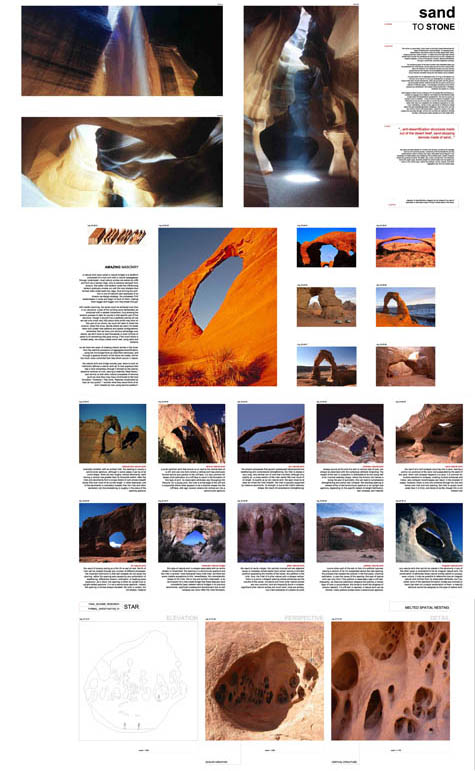 [Images: From Magnus Larsson's Dune: Arenaceous Anti-Desertification Architecture].
[Images: From Magnus Larsson's Dune: Arenaceous Anti-Desertification Architecture].
Clarifying the biochemical process through which his project could be realized, Larsson explained in a series of emails that his "structure is made straight from the dunescape by flushing a particular bacteria through the loose sand... which causes a biological reaction whereby the sand turns into sandstone; the initial reactions are finished within 24 hours, though it would take about a week to saturate the sand enough to make the structure habitable."
The project – a kind of bio-architectural test-landscape – would thus "go from a balloon-like pneumatic structure filled with bacillus pasteurii, which would then be released into the sand and allowed to solidify the same into a permacultural architecture."
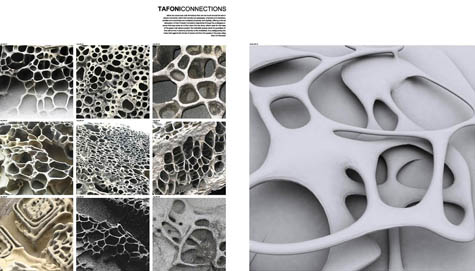 [Image: From Magnus Larsson's Dune: Arenaceous Anti-Desertification Architecture].
[Image: From Magnus Larsson's Dune: Arenaceous Anti-Desertification Architecture].
The "architectural form" of the resulting solidified sandscape is actually "derived from tafoni," Larsson writes, where tafoni is "a cavernous rock structure that formally ties the project back to notions of aggregation and erosion. On a conceptual scale, the project spans some 6,000km, putting it on a par with Superstudio's famous Continuous Monument – but with an environmental agenda."
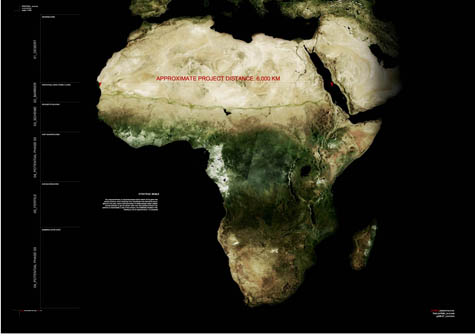
 [Images: From Magnus Larsson's Dune: Arenaceous Anti-Desertification Architecture].
[Images: From Magnus Larsson's Dune: Arenaceous Anti-Desertification Architecture].
I'm reminded of Michael Welland's recent book Sand. There, Welland describes "how deserts operate" (he compares them to "engines" of mechanical weathering); he points out that you can still find "sand-sized fragments of steel" on the D-Day beaches of Normandy, war having left behind a hidden desert of metal; and he mentions that the UK now maintains "the world's first database of sand" – but that it's used "specifically for police forensics."
Welland's descriptions of sand dune physics are particularly memorable. He writes, for instance, that an avalanche is really a sand dune being "overwhelmed by the huge number of very small events" on its surface, and that these "very small events" unpredictably lead to one decisive moment of cascading self-collapse.
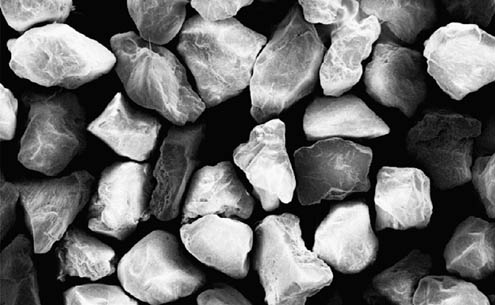 [Image: A photomicrograph of sand grains].
[Image: A photomicrograph of sand grains].
Fantastically, though, and more relevant to this post, he then compares the internal structure of sand dunes to Gothic cathedrals: the grains of sand piled high form "microscopic chains and networks... in such a way that they carry most of the pressure from the weight of the material above them." This is the architecture of sand:
 [Images: From Magnus Larsson's Dune: Arenaceous Anti-Desertification Architecture].
[Images: From Magnus Larsson's Dune: Arenaceous Anti-Desertification Architecture].
Larsson's project descriptions maintain this somewhat hallucinatory feel:
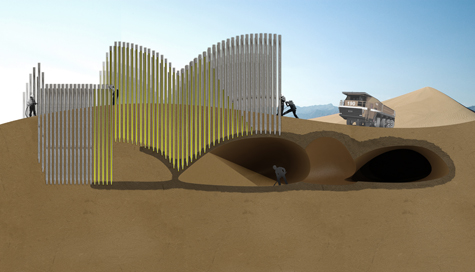 [Image: From Magnus Larsson's Dune: Arenaceous Anti-Desertification Architecture].
[Image: From Magnus Larsson's Dune: Arenaceous Anti-Desertification Architecture].
Larsson goes on to contrast his method with existing vernacular techniques of anti-desertification:
Which leads me to ask: where is landscape architecture's Aleister Crowley, Madame Blavatsky, or even John Dee? Mystics of terrestrial form, hacking the periodic table of the elements inside makeshift labs.
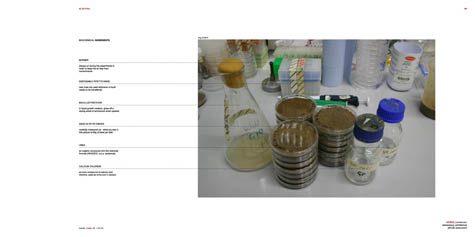
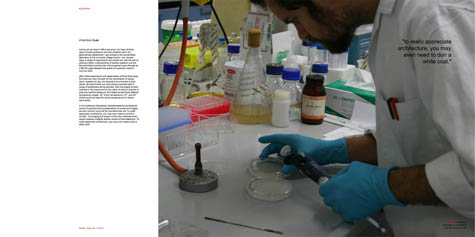
 [Images: Synthesizing rare earth compounds – bioterrestriality; from Magnus Larsson's Dune: Arenaceous Anti-Desertification Architecture].
[Images: Synthesizing rare earth compounds – bioterrestriality; from Magnus Larsson's Dune: Arenaceous Anti-Desertification Architecture].
In any case, Larsson's "solidified dunes," we read, would also "support the existing Green Wall Sahara initiative: 24 African countries coming together to plant a shelterbelt of trees right across the continent, from Mauritania in the west to Djibouti in the east, in order to mitigate against the encroaching desert."


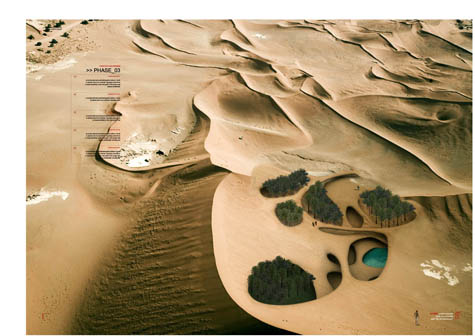 [Images: From Magnus Larsson's Dune: Arenaceous Anti-Desertification Architecture].
[Images: From Magnus Larsson's Dune: Arenaceous Anti-Desertification Architecture].
Clearly having thought through the project in extraordinary detail, Larsson then points out that the structure itself would generate a "temperature difference between the interior of the solidified dunes and the exterior dune surface." This then "makes it possible to start building a permacultural network, the nodal points of which would support water harvesting and thermal comfort zones that can be inhabited."
 [Image: The view from within; from Magnus Larsson's Dune: Arenaceous Anti-Desertification Architecture].
[Image: The view from within; from Magnus Larsson's Dune: Arenaceous Anti-Desertification Architecture].
Eventually, then, a 6000km-long wall of permaculturally active, inhabited architecture will span the Sahara.
Check out more images in this Flickr set for the project, or read a bit more about the project over at the Holcim Foundation.
 [Image: From Magnus Larsson's Dune: Arenaceous Anti-Desertification Architecture].
[Image: From Magnus Larsson's Dune: Arenaceous Anti-Desertification Architecture].Larsson's project deservedly won first prize last fall at the Holcim Foundation's Awards for Sustainable Construction held in Marrakech, Morocco.
One of the most interesting aspects of the project, I think, is that this solidified dunescape is created through a particularly novel form of "sustainable construction" – that is, through a kind of infection of the earth.
In other words, Larsson has proposed using bacillus pasteurii, a "microorganism, readily available in marshes and wetlands, [that] solidifies loose sand into sandstone," he explains.
 [Image: From Magnus Larsson's Dune: Arenaceous Anti-Desertification Architecture].
[Image: From Magnus Larsson's Dune: Arenaceous Anti-Desertification Architecture].Larsson points out the work of the Soil Interactions Lab at UC-Davis, which describes itself as "harnessing microbial activity to solidify problem soils."
But the idea of taking this research and applying it on a megascale – that is, to a 6,000km stretch of the Sahara Desert – boggles the mind. At the very least, the idea that this might be deployed for the wrong reasons, or by the wrong people, in some delirious hybrid of ice-nine, J.G. Ballard's The Crystal World, and perhaps a Roger Moore-era James Bond film, deserves further thought.
An epidemic of bacillus pasteurii infects all the loose sand in the world, forming great aerodynamic fins and waves in a kind of global Utah of glassine shapes.
 [Images: From Magnus Larsson's Dune: Arenaceous Anti-Desertification Architecture].
[Images: From Magnus Larsson's Dune: Arenaceous Anti-Desertification Architecture].Clarifying the biochemical process through which his project could be realized, Larsson explained in a series of emails that his "structure is made straight from the dunescape by flushing a particular bacteria through the loose sand... which causes a biological reaction whereby the sand turns into sandstone; the initial reactions are finished within 24 hours, though it would take about a week to saturate the sand enough to make the structure habitable."
The project – a kind of bio-architectural test-landscape – would thus "go from a balloon-like pneumatic structure filled with bacillus pasteurii, which would then be released into the sand and allowed to solidify the same into a permacultural architecture."
 [Image: From Magnus Larsson's Dune: Arenaceous Anti-Desertification Architecture].
[Image: From Magnus Larsson's Dune: Arenaceous Anti-Desertification Architecture].The "architectural form" of the resulting solidified sandscape is actually "derived from tafoni," Larsson writes, where tafoni is "a cavernous rock structure that formally ties the project back to notions of aggregation and erosion. On a conceptual scale, the project spans some 6,000km, putting it on a par with Superstudio's famous Continuous Monument – but with an environmental agenda."

 [Images: From Magnus Larsson's Dune: Arenaceous Anti-Desertification Architecture].
[Images: From Magnus Larsson's Dune: Arenaceous Anti-Desertification Architecture].I'm reminded of Michael Welland's recent book Sand. There, Welland describes "how deserts operate" (he compares them to "engines" of mechanical weathering); he points out that you can still find "sand-sized fragments of steel" on the D-Day beaches of Normandy, war having left behind a hidden desert of metal; and he mentions that the UK now maintains "the world's first database of sand" – but that it's used "specifically for police forensics."
Welland's descriptions of sand dune physics are particularly memorable. He writes, for instance, that an avalanche is really a sand dune being "overwhelmed by the huge number of very small events" on its surface, and that these "very small events" unpredictably lead to one decisive moment of cascading self-collapse.
 [Image: A photomicrograph of sand grains].
[Image: A photomicrograph of sand grains].Fantastically, though, and more relevant to this post, he then compares the internal structure of sand dunes to Gothic cathedrals: the grains of sand piled high form "microscopic chains and networks... in such a way that they carry most of the pressure from the weight of the material above them." This is the architecture of sand:
- These chains seem to behave like the soaring arches of Gothic cathedrals, which serve to transmit the weight of the roof, perhaps a great dome, outward to the walls, which bear the load.
- Most of today's active sandy deserts are surrounded by vast stretches of old stabilized dunes, formed as the trade-wind belts and arid regions expanded in the cold, dry climate of the last ice age and immobilized as the climate changed. However, continuing shifts in the climate may bring these fixed ergs, granular reserves awaiting activation, back to life.
- The hills were stabilized eight hundred years ago but have had episodes of reincarnation since: a long drought toward the end of the eighteenth century resuscitated dunes on the Great Plains, whose activity caused problems for the westbound wagon trains decades earlier.
 [Images: From Magnus Larsson's Dune: Arenaceous Anti-Desertification Architecture].
[Images: From Magnus Larsson's Dune: Arenaceous Anti-Desertification Architecture].Larsson's project descriptions maintain this somewhat hallucinatory feel:
- I researched different types of construction methods involving pile systems and realised that injection piles could probably be used to get the bacteria down into the sand – a procedure that would be analogous to using an oversized 3D printer, solidifying parts of the dune as needed. The piles would be pushed through the dune surface and a first layer of bacteria spread out, solidifying an initial surface within the dune. They would then be pulled up, creating almost any conceivable (structurally sound) surface along their way, with the loose sand acting as a jig before being excavated to create the necessary voids. If we allow ourselves to dream, we could even fantasise about ways in which the wind could do a lot of this work for us: solidifying parts of the surface to force the grains of sand to align in certain patterns, certain shapes, having the wind blow out our voids, creating a structure that would change and change again over the course of a decade, a century, a millenium.
 [Image: From Magnus Larsson's Dune: Arenaceous Anti-Desertification Architecture].
[Image: From Magnus Larsson's Dune: Arenaceous Anti-Desertification Architecture].Larsson goes on to contrast his method with existing vernacular techniques of anti-desertification:
- Traditional anti-desertification methods include the planting of trees and cacti, the cultivation of grasses and shrubs, and the construction of sand-catching fences and walls. More ambitious projects have ventured into the development of agriculture and livestock, water conservation, soil management, forestry, sustainable energy, improved land use, wildlife protection, poverty alleviation, and so on. This project, apart from utilising a completely new way of turning sand into sandstone, incorporates all of the above. Inside the dunes, we can take care of our plants and animals, find water and shade, help the soil remain fertile, care for the trees, and so on. In this way, it's an environmental project that hopefully provides an innovation for other architects/builders to use and copy time and time again.
Which leads me to ask: where is landscape architecture's Aleister Crowley, Madame Blavatsky, or even John Dee? Mystics of terrestrial form, hacking the periodic table of the elements inside makeshift labs.


 [Images: Synthesizing rare earth compounds – bioterrestriality; from Magnus Larsson's Dune: Arenaceous Anti-Desertification Architecture].
[Images: Synthesizing rare earth compounds – bioterrestriality; from Magnus Larsson's Dune: Arenaceous Anti-Desertification Architecture].In any case, Larsson's "solidified dunes," we read, would also "support the existing Green Wall Sahara initiative: 24 African countries coming together to plant a shelterbelt of trees right across the continent, from Mauritania in the west to Djibouti in the east, in order to mitigate against the encroaching desert."


 [Images: From Magnus Larsson's Dune: Arenaceous Anti-Desertification Architecture].
[Images: From Magnus Larsson's Dune: Arenaceous Anti-Desertification Architecture].Clearly having thought through the project in extraordinary detail, Larsson then points out that the structure itself would generate a "temperature difference between the interior of the solidified dunes and the exterior dune surface." This then "makes it possible to start building a permacultural network, the nodal points of which would support water harvesting and thermal comfort zones that can be inhabited."
 [Image: The view from within; from Magnus Larsson's Dune: Arenaceous Anti-Desertification Architecture].
[Image: The view from within; from Magnus Larsson's Dune: Arenaceous Anti-Desertification Architecture].Eventually, then, a 6000km-long wall of permaculturally active, inhabited architecture will span the Sahara.
Check out more images in this Flickr set for the project, or read a bit more about the project over at the Holcim Foundation.





Comments are moderated.
If it's not spam, it will appear here shortly!
Larsson has developed a program that is fascinating to think about. The structural method of using the sand both as primary ingredient of the finished structure and also as formwork seems realistic and shares a common method with the work of engineer Heinz Isler. He too looked to berms and dunes of sand as a means of formwork. Larsson may have one-upped Isler by using the same sand as the aggregate.
This is an incredibly interesting design project. It shows extremely creative and careful thinking. Desertification is certainly a problem in many regions and I think that we can all agree that humans and their technology have a part to play in reversing the current trend. However this project brings to mind something that Percy Bysshe Shelley once wrote in his great poem Ozymadias:
Look on my works, ye mighty, and despair!'
Nothing beside remains. Round the decay
Of that colossal wreck, boundless and bare,
The lone and level sands stretch far away.
The Sahara is a fascinating and rich habitat and a biotop though it seems dry and dead to many today. Magnus Larsson's proposed project would change and destroy this possibly. But it's a fantastic projekt idea with a lots of innovative details. It would be more remarkable then the Chinese Wall.
I love Magnus Larsson and his super-genious idea.
Hurrah!
A revolutionary idea, which was beautifully documented, great work!
You know I love it Magnus!!! I can't wait to see it tested and implemented. We should talk more about how to keep pursuing its realization in the summer.
This is a really fascinating project. I like how the architect actually went into the laboratory to do experiments with what would effectively be a new material. The scale is crazy, but I suppose we need to think big to tackle problems such as desertification. Thanks for yet another great write-up, Geoff!
Mr Larsson is a genius! Wow.
This sounds like a fascinating project. If the construction process is viable it could be incredibly important, not necessarily for so grand a scheme as holding back the desert, but as a concrete without any cement. So, without jumping to a continental scale it could have a huge impact on sustainable construction both environmentally and in terms of local sourcing of materials.
Wow! What an extraordinary, creative, and visionary idea. And what stunning images. Your description of "A vast 3D printer made of bacteria crawls undetectably through the deserts of the world, printing new landscapes into existence over the course of 10,000 years..." is wonderfully evocative and provocative.
And, while I'm here, thanks for the use of quotes from my book (I mentioned the bacteria in terms of lithifying sands into sandstone to prevent earthquake liquefaction and the consequent building damage, but this is, in every sense, fantastic).
Amazing project. Can't wait to see it live...
This is visionary outside the box amazing borderline on acid. Make it more than a mirage!
Hmmm...on a day when the Corps of engineers is being sued for its attempts to control nature and instead opening a landscape to incredible devastation (http://www.nytimes.com/2009/04/21/us/21katrina.html?ref=us) and on the same day Design Observer (http://www.designobserver.com/archives/entry.html?id=39417#more) celebrates a craft initiative to draw attention to the destruction of coral reef brought by other interventions in nature, it is provocative to read in several places this celebration of a massively intrusive wall (Superstudio's "Continuous Monument"?)as a good thing to do.
Very interesting, worth investigating further.
High potential for abuse, though, as the author alludes to. How do you turn the bacteria off? What about spontaneous mutations leading to unpredicted syntheses?
It needs more emphasis on greenery and water. Without more of that, it just seems a bit like hyper-sophisticated stonework or concrete work.
Having said all that, though, I like the idea quite a lot. Very cool, and tremendous potential.
How about growing small houses or shelters out of it, instead of another Great Wall?
Magnus Larsson is a true hero!
Amazing, amazing, amazing. You rock!
One Magnus Larsson, there's only one Magnus Larsson...
Wow, what vision. Absolutely amazing proposal, talk about thinking outside the box. Well done.
Incredible idea! I had no idea those landforms were the result of micro-oganisms.
The original paper about microbially induced cementation is available here as a PDF. Reading it though, one notes that you have to do a lot more than just inject microbes. They need water, nutrients, additional oxygen, a calcium source from which to precipitate the calcite cement, etc. On the scale of a building foundation it might be feasible, but on the scale of a 6000km long wall crossing the Sahara... well, "challenging" seems like an understatement. Basically all the microbes are doing is acting as a catalyst. You still have to provide all the materials required to form the cement.
A fascinating take upon the idea of combating desertification. I did at first also have the notion as stated in the article that if left to its own devices the microbes would become hard to handle (ice 9). However, if handled properly and in a way to facilitate the growth of plants and habitats for humans this could indeed be revolutionary!
It is a great idea but I think its application should be focused no 'curing' desertification. I am concerned about the possibility that it my transform the whole desert.
The original article was undoubtedly peer-reviewed by environmental engineers, but was it also reviewed by microbial ecologists? The bacteria may be non-pathogenic and native, but artificial population increases can still cause problems for other species.
The suggested application is a lofty endeavor but may not provide as many benefits as expected. Wind erosion does play an important role in natural desesrtification. But the rapid process we see today has been caused by human alterations in the surrounding ecosystems. Restoring the original vegetation and putting limits on grazing would be more effective and less expensive.
I'd want to see solid evidence that the bacteria can be contained, but otherwise it's an excellent project. The Sahara has been massively enlarged by human activity so from an environmental perspective, containing it via human activity doesn't bother me. There's something about this that is very reminiscent of the climatic and environmental design in Frank Herbert's Dune... it has almost the same scope.
I think that's a start and further research might help them arrive at simpler and more robust solutions such as using grass succession and tree planting to stabilize and build soils structures.
All great and all, but how do you suppose to stop this bacillus to turn the whole Sahara into one giant rock?
And isn't it crazy how people go all nuts about something that would once again destroy entire habitats? The Sahara isn't a dead place people! A 6000km wall grown by bacteria? Gimme a break!
Arty farty stuff with no grounds in decent science.
The giant rock theory is very interesting, yet why people come up with it is totally beyond me, could anyone elaborate? The bacteria doesn't perform photosynthesis, and it needs more than just sand to make sandstone, am I overlooking anything obvious?
This is a really interesting and innovative project which I hopes works, if it does, can actually be implemented/will be implemented. But one thing still really bothers me...the introduction of a new organism to an area can completely decimate it. How do we know that this wouldn't happen here?
The complaints that the bacteria could turn every desert into one massive sandstone are ridiculous. For this process to work, one has to ship in food for the bacteria: it needs water and minerals with specific arrangements of calcium within. Without these things being imported continuously, the bacteria die. Poof, they're gone.
This isn't going to "destroy entire habitats", either. The best analogy I can think of is cutting down a few trees on the edge of a forest to make a wooden fence that stops the forest from extending beyond a certain point.
Tom&Ann, Before you claim this has no grounds in decent science, you should probably learn what decent science is.
Anonymous, you have every right to chide me about the giant rock fear mongering theory. I admit it was dumb, and regretted posting it as soon as I hit the submit button. It was the perfect example of what I was trying to denounce.
Yet I still refuse to be as enthusiastic as most in this comment thread, and I continue to stress that this is an art piece, not sufficiently thought through scientifically, or even practically. The devil really is in the details, and I don't feel the details have been worked out here. Or can be for that matter.
Introducing a foreign organism at this scale seems like a very dangerous game to play. Even if it can be guaranteed to die off without being fed specific nutrients. In that case we have to include the environmental impact of the nutrients themselves. The transport of the ingredients, and the biochemical changes to the local environment due to foreign substances. Not to talk about growing a bacillus monoculture at a massive scale.
It sounds great on paper, but in reality, it's hubris.
Can't we learn from our mistakes? Be more cautious, skeptical? Introduction of organisms in foreign habitats has had generally disastrous effects in the past, *especially* with germs, the world of which we barely know today.
http://www.actionbioscience.org/biodiversity/simberloff.html
http://en.wikipedia.org/wiki/Guns,_Germs,_and_Steel
Why do we have the audacity to think that we know every consequence of introducing this particular bacillus into the Sahara?
Anonymous, this is way more than a wooden fence around the forest. First, it's at a way grander scale - the scale of an entire ecosystem. It's as if you would somehow wall off the antarctic by freezing a ring of oceans around it all the way to the ocean floor. And second, your wooden fence is made from the forest's own wood. Not so with the desert wall - it's mainly built from imported nutrients. I think a better comparison would be a highway through the forest. And we all know that that doesn't do any good to the various forest habitats.
Again, it's a great *idea*, worthy of further investigation, but proposing it at this scale is -I hope- only a marketing ploy to get this art project some visibility.
I'm open for further discussion.
What an outrageous concept, not sure what the outcome would be, or if it is even at all possible. It was great reading.
It's really unfortunate that the wonderful African Refugee map is in fact stolen from someone else and is in no way credited to the original author: It was created by Heather Francisco, class project for Geog 572 Fall '06. See the original here.
Stealing other folks intellectual property and getting famous from it just isn't cool.
I totally dig it.
Deserts have very little water....I am not sure who you ll sustain populations is water strategies are not resolved!
Great Idea,
Being and engineer and not a biologist what is the tolerance envelope of the bacteria. What temperatures can they stand, can they stand high ph levels etc....
So, where do we go from here? Let's do it!
Post a Comment